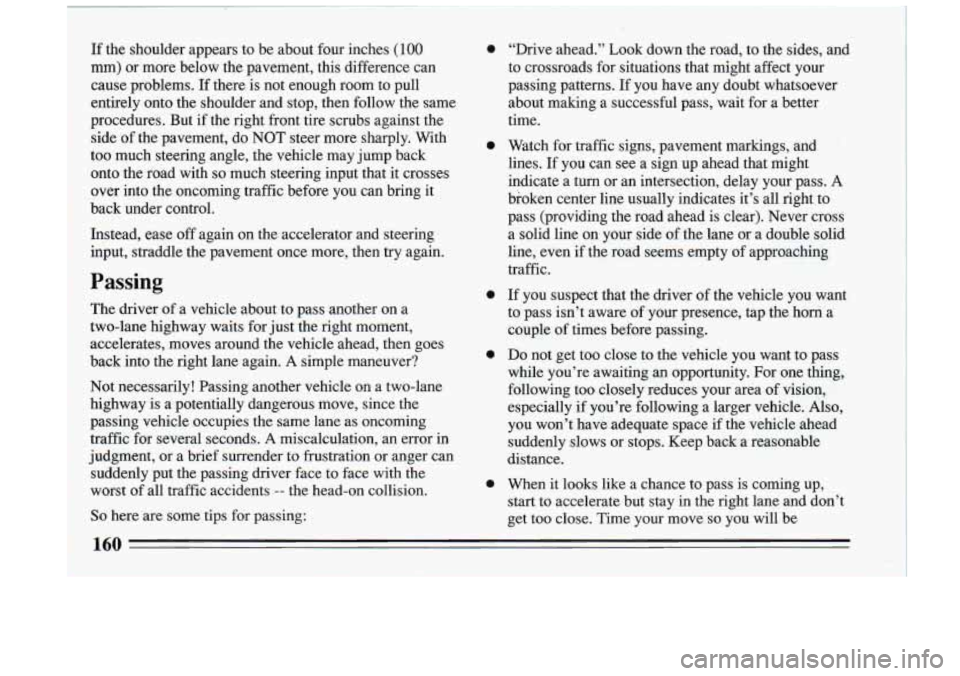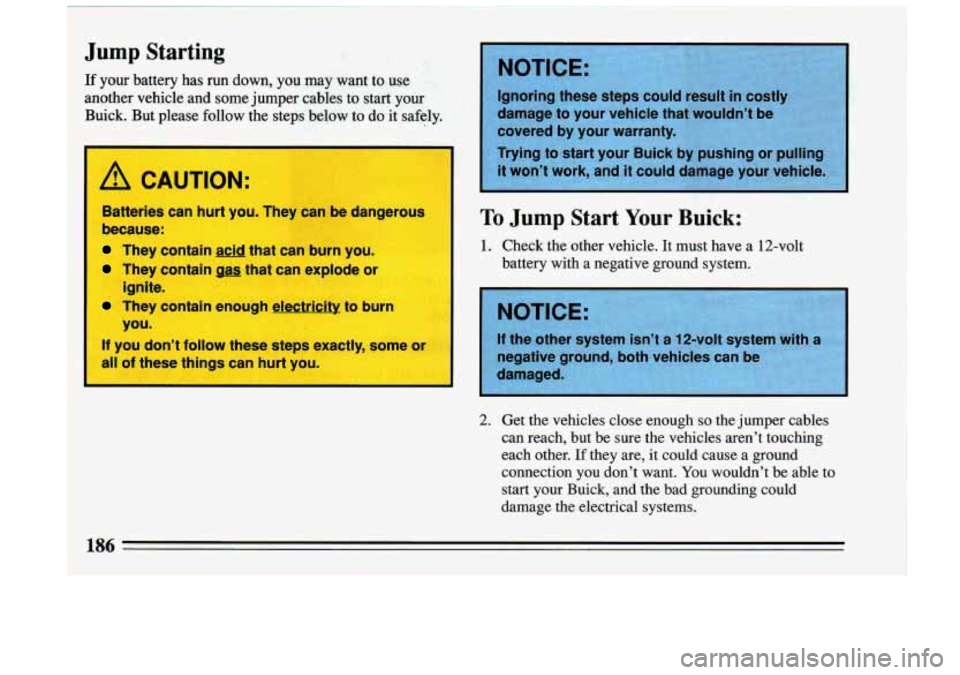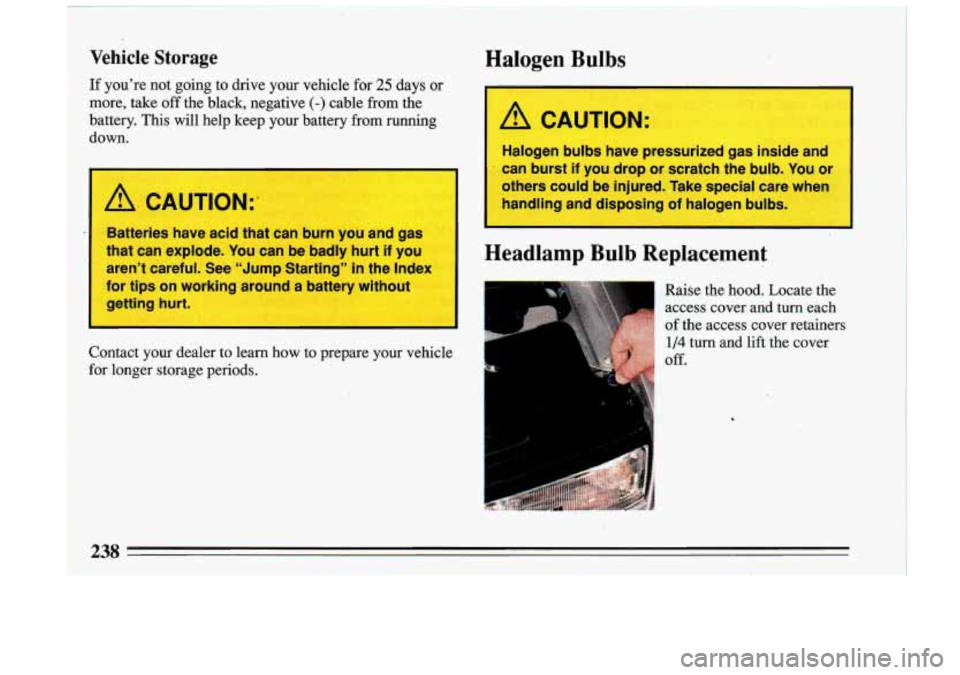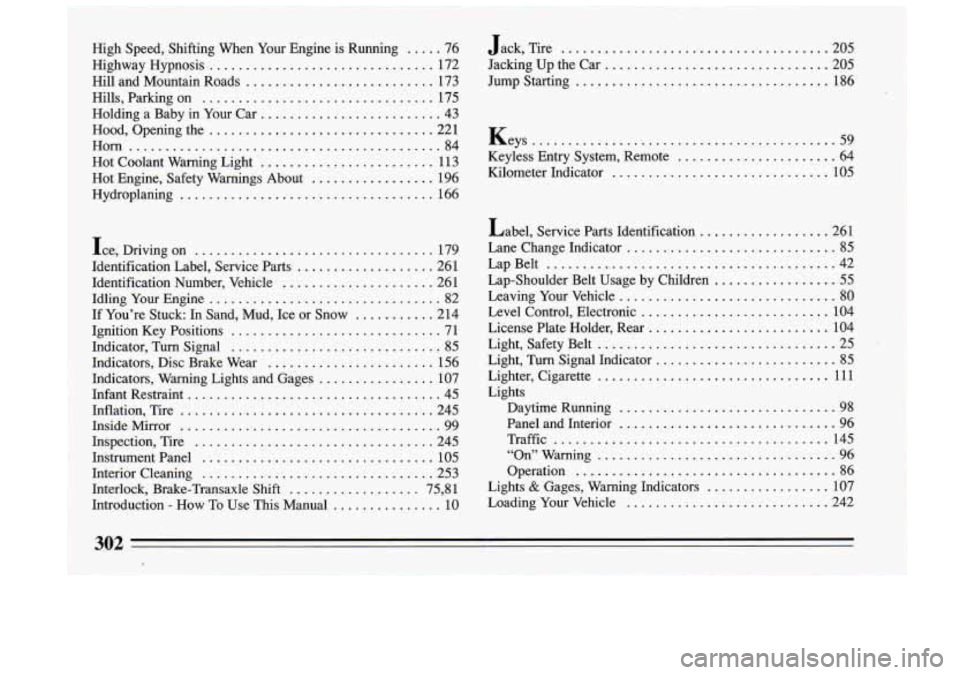1993 BUICK RIVIERA jump start
[x] Cancel search: jump startPage 162 of 324

If the shoulder appears to be about four inches (100
mm) or more below the pavement, this difference can
cause problems.
If there is not enough room to pull
entirely onto the shoulder and stop, then follow the same
procedures. But if the right front tire scrubs against the
side of the pavement, do NOT steer more sharply. With
too much steering angle, the vehicle may jump back
onto the road with
so much steering input that it crosses
over into the oncoming traffic before you can bring it
back under control.
Instead, ease off again on the accelerator and steering
input, straddle the pavement once more, then try again.
Passing
The driver of a vehicle about to pass another on a
two-lane highway waits for just the right moment,
accelerates, moves around the vehicle ahead, then goes
back into the right lane again. A simple maneuver?
Not necessarily! Passing another vehicle on a two-lane
highway is a potentially dangerous move, since the
passing vehicle occupies the same lane as oncoming
traffic for several seconds. A miscalculation, an error
in
judgment, or a brief surrender to frustration or anger can
suddenly put the passing driver face to face with the
worst of all traffic accidents
-- the head-on collision.
So here are some tips for passing:
0
0
0
0
0
“Drive ahead.” Look down the road, to the sides, and
to crossroads for situations that might affect your
passing patterns. If you have any doubt whatsoever
about making a successful pass, wait for a better
time.
Watch for traffic signs, pavement markings, and
lines.
If you can see a sign up ahead that might
indicate a turn or an intersection, delay your pass.
A
broken center line usually indicates it’s all right to
pass (providing the road ahead
is clear). Never cross
a solid line on your side of the lane or a double solid
line, even
if the road seems empty of approaching
traffic.
If you suspect that the driver of the vehicle you want
to pass isn’t aware of your presence,, tap the
horn a
couple of times before passing.
Do not get too close to the vehiclc 3u want to pass
while you’re awaiting an opportunny. For one thing, following too closely reduces your area of vision,
especially
if you’re following a larger vehicle. Also,
you won’t have adequate space
if the vehicle ahead
suddenly slows
or stops. Keep back a reasonable
distance.
~~
When it looks like a chance to pass is coming up,
start to accelerate but stay in the right lane and don’t
get too close. Time your move
so you will be
160
Page 188 of 324

1
1 Jump Starting
1 If your battery has run down, you may want to use
1 another vehicle and some jumper cables to start your
1 Buick. But please follow the steps below to do it safely.
Batteries can hurt you. They can be dangerous
because:
They contain acid that can burn you.
They contain ass that can explode or
They contain enough electricity to burn
ignite.
you.
I
If you don’t follow these steps exactly, some or
all
of these things can hurt you. cowered
by your warrant
Trying
to start your Buick by pushing or pulling
it won’t work, and it could damage your vehicle.
To Jump Start Your -’ ick:
1. Check the other vehicle. It must have a 12-volt
battery with a negative ground system.
2. Get the vehicles close enough so the jumper cables
can reach, but be sure-the vehicles aren’t touching
each other.
If they are, it could cause a ground
connection
you don’t want. You wouldn’t be able to
start your Buick, and the bad grounding could
damage the electrical systems.
Page 240 of 324

Vehicle Storage Halogen Bulbs
If you’re not going to drive your vehicle for 25 days or
-more, take
off the black, negative (-) cable from the
.battery. This will help keep your battery from running
:down.
I
A CAUTION:;
Batteries have acid that can burn you and gas
that can explode. You can be badly hurt if you
aren’t careful. See “Jump Starting’’
in the Index
for tips on working around a battery without
getting hurt. I
Contact your dealer to learn how to prepare your vehicle
:for longer storage periods.
I
A CAUTION:
t
Halogen bulbs have pressurized gas inside and
can burst
if you drop or scratch the bulb. You or
others could be injured. Take special care when
handling and disposing of halogen bulbs.
I
Headlamp Bulb Replacement
1 access cover and turn each
’ of the access cover retainers
1/4 turn and lift the cover
Off.
238
Page 304 of 324

High Speed. Shifting When Your Engine is Running ..... 76 Jack. Tire ..................................... 205
Highway Hypnosis
............................... 172 Jacking Up the Car ............................... 205
Hill and Mountain Roads
.......................... 173 Jump Starting ................................... 186
Hills. Parking on
................................. 175
Holding a Baby in Your Car
......................... 43
Hood. Opening the
............................... 221
Horn ........................................... 84 Keys 59
Hot Coolant Warning Light
........................ 113 Keyless Entry System. Remote 64
Hydroplaning
................................... 166
..........................................
......................
Hot Engine. Safety Warnings About 196 Kilomefa- J&$q$cx .. +... .? . ... _. % ......... . ... .’_ rs.z7 t- ........ . 105 .................
Ice. Driving on ................................. 179
Identification Label. Service Parts
................... 261
Identification Number. Vehicle
..................... 261
Idling Your Engine
................................ 82
If You’re Stuck: In Sand. Mud. Ice or Snow
........... 214
Indicator. Turn Signal
............................. 85
Indicators. Disc Brake Wear ....................... 156
Indicators. Warning Lights and Gages
................ 107
Infant Restraint
................................... 45
Inflation. Tire
................................... 245
Inside Mirror
.................................... 99
Inspection. Tire
................................. 245
Instrument Panel
................................ 105
Interior Cleaning
................................ 253
Interlock. Brake-Transaxle Shift
.................. 75. 81
Introduction
. How To Use This Manual ............... 10
Ignition Key Positions
............................. 71
Label.
Service Parts Identification
.................. 261
Lane Change Indicator
............................. 85
Lap-Shoulder Belt Usage by Children
................. 55
Leaving Your Vehicle .............................. 80
Level Control. Electronic
.......................... 104
License Plate Holder. Rear
......................... 104
Light. Safety Belt
................................. -25
Light.
Turn Signal Indicator ......................... 85
Lighter. Cigarette
................................ 111
Lights Daytime Running
.............................. 98
Panel and Interior
.............................. 96
Traffic
...................................... 145
“On” Warning
................................. 96
Operation
.................................... 86
Loading Your Vehicle ............................ 242
Lap Belt
........................................ -42
Lights
& Gages. Warning Indicators ................. 107
302